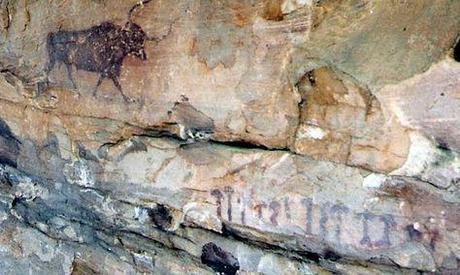Cognitive archaeologist David Lewis-Williams has long argued that the spectacular Paleolithic paintings in European caves such Lascaux, Chauvet, and Altamira were created by early shamans who were experiencing altered states of consciousness (“ASC”). Because Paleolithic rock art around the world displays the same or similar types of symbols, which Lewis-Williams calls “entoptics,” he contends that altered states of consciousness based on a universal cognitive architecture gives rise to these internal images, which are then rendered onto rock art. ASC’s can be induced in several ways, with one of the most important being the ingestion of psychotropics.
In a recent study, Brian Akers and colleagues report on a 6,000 rock shelter mural in Spain. As is true of so many Paleolithic cave paintings, this one depicts a bull (which is most likely a wild auroch). What makes this mural unique, however, is that it also depicts mushrooms of the psychotropic or tripping variety (Psilocybe hispanica):

Selva Pascuala Rock Art
At the bottom right, there are 13 images of what the authors consider to be psychotropic mushrooms native to this region of Spain. After noting that ritual or shamanic usage of neurotropic fungi has been widely documented in Mexico, Siberia and elsewhere in the world, the authors suggest that the Selva Pasualal mural was created under circumstances. The close proximity of the magic mushrooms with the bull, which is often depicted in cave paintings that are many thousands of years older than the bull at Selva Pasuala, is fairly convincing proof that such depictions were created by shamans experiencing altered states of consciousness.
It is worth noting that the majority of these depictions are located in difficult to access places and may only have been visited by shamans. If this is the case, it suggests that the earliest forms of supernaturalism may not have been group oriented but instead were the private domain of ritual specialists or shamans.
Reference:
Akers, B., Ruiz, J., Piper, A., & Ruck, C. (2011). A Prehistoric Mural in Spain Depicting Neurotropic Psilocybe Mushrooms? Economic Botany DOI: 10.1007/s12231-011-9152-5


